Co-working Statistics By Co-working Benefits, Country, Workers, Demographics, Region and Productivity

Page Contents
- Introduction
- Editor’s Choice
- Facts About Co-working
- General Co-working Statistics
- Interesting Co-working Statistics
- by Co-working Benefits
- Co-working Space Utilization Statistics by Country
- by Workers
- by Demographics
- Co-working Spaces Market Statistics by Region and Country
- by Workspace Business
- Statistics Co-working Space Providers
- by Spaces in Demand
- by Location, Perks, and Amenities
- by Desk Cost
- by Top Players
- by Productivity
- Conclusion
Introduction
Co-working Statistics: As of reports the industry of co-working is enhancing rapidly and it is very important to track all its latest statistics that will allow an understanding of achievable and accurate goals of the business across the world. Co-working spaces generate a positive working environment that allows workers to share services, facilities, and tools.
By the end of 2027, the global market value of co-working space is expected to be $34.99 billion and with each passing year, it has been observed that women’s representation in the working sphere. The Co-working Statistics include insights from various aspects for understanding the market of co-working business and its importance.
Editor’s Choice
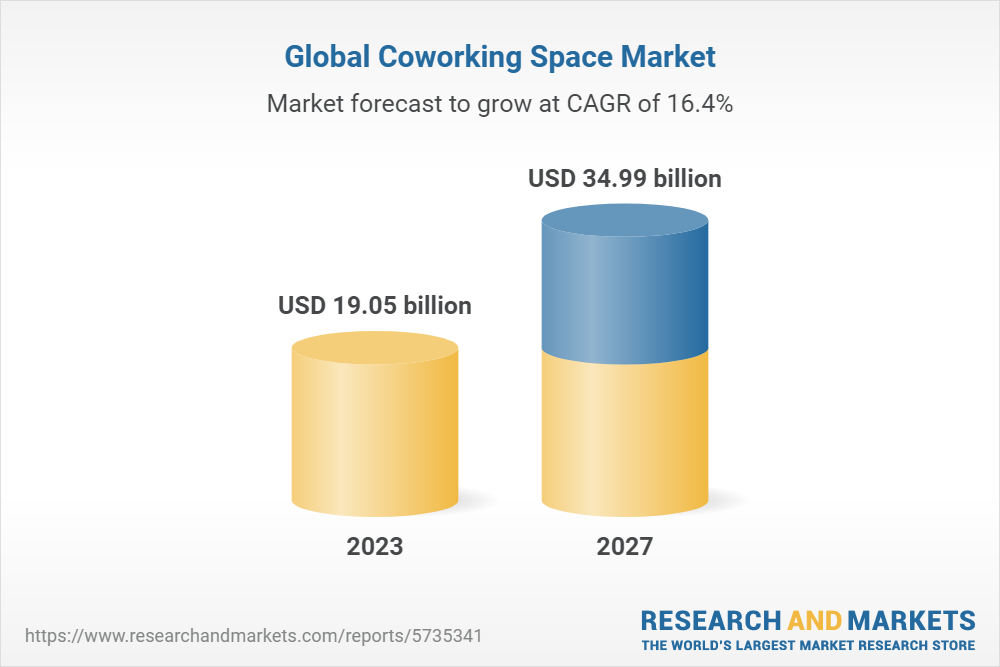
- As of 2023, the biggest market of co-working spaces is currently the Asia-Pacific region and by the end of 2023, the global market share of co-working space is expected to reach $19.05 billion.
- According to Statista, all over the world, the number of co-working spaces is expected to be 41,975 by the end of 2024, and in 2022 it was observed to be 18,700.
- According to SAP research, co-working spaces have enabled 75% of businesses to see a positive and strong relationship.
- In 2023, Co-working became part of mixed-use developments in North America, with businesses, restaurants, entertainment, and residential surrounded by workspaces.
- According to Allwork. Space In 2022, in businesses outside the United States almost 13% were using shared workspaces.
- As of 2023, almost 83% of users of co-working space have actively chosen mobile applications as the preferred tool for managing overall co-working services.
- Co-working spaces have enhanced around 67% of co-workers' career achievements.
- In 2023, almost 5.07 million individuals have joined co-working spaces of which 37% of users are freelancers, 24% users are entrepreneurs, and 215 represent SMEs.
- Over the world, 30% of global co-working spaces are profitable to date.
Facts About Co-working
- Almost 69% of companies have shifted towards flexible workplace options and reduced the use of traditional office space by the end of 2022.
- In 2023, it is expected that 50% of companies are going to shutter above 25% of traditional offices.
- 50% of the global co-working market share was accounted for by WeWork and IWG resulting above 3000+ businesses.
- According to Deskmag, 57% of co-working spaces had apps to book spaces which allow connecting with members.
- Whereas, 70% of members of co-working spaces were using digital cards and mobile apps for accessing spaces.
- 23% of co-working spaces have provided digital mailboxes and business address services.
- As the need for a hybrid workforce has increased 50% of companies are expecting to reduce their office footprint in 2023.
- A combination of co-working, office, and home was preferred by 45% of the workforce.
- To accommodate a hybrid team, 72% of companies utilized co-working spaces.
- 25% less power is required in co-working spaces as compared to traditional offices.
- Sustainability initiatives have been implemented with 62% of spaces that enable recycling, greener commuting, etc.
- Whereas, co-working spaces have enabled less production of greenhouse gas emissions by 25% to 50%.
- The asset performance has been improved after implementing co-working partnership plans which was agreed by 72% of property owners.
- For activating underutilized space in their buildings was used by 8% of co-working members.
General Co-working Statistics
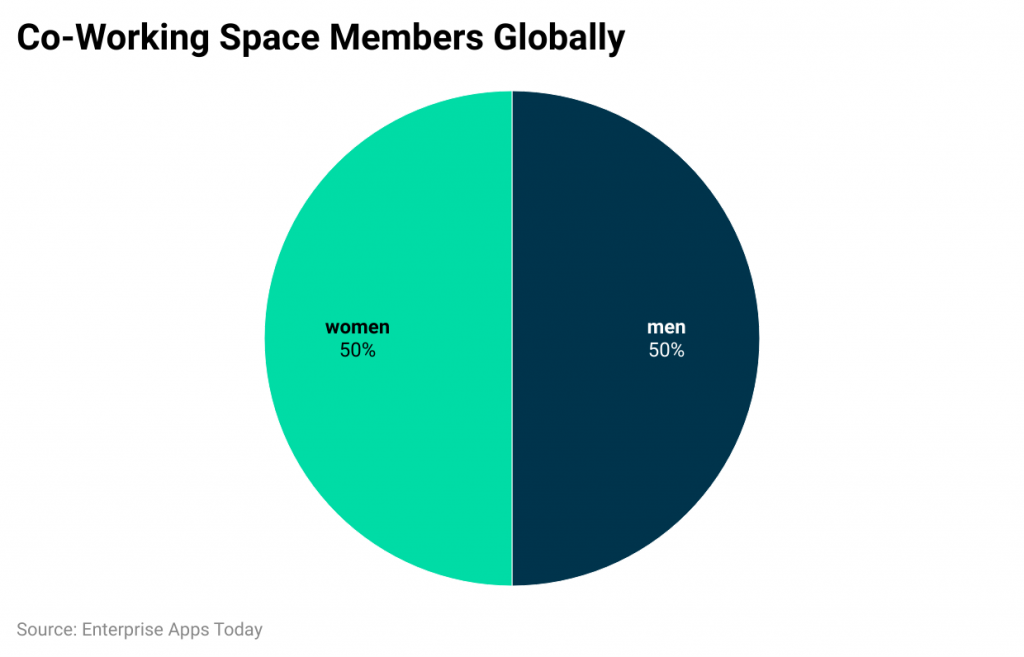 (Source: .gitnux.com)
(Source: .gitnux.com)
- The largest market for co-working spaces in 2022 was China, while in the case of new co-working space openings London and New York are the top two cities in the world.
- The co-working industry has experienced an increase in annual growth rate by 6% along with allowing working flexibility which enhanced the performance level.
- In 2022, co-working spaces enabled 70% of members to become healthier, 68% of members were found more focused, and 64% of members completed their tasks in properly executed timings.
- The co-working spaces and booking platforms made a partnership and termed as a partnership year that enhanced the ability of corporate employees so, that they can work easily from any co-working space across the world.
- In 2023 the co-working demographics were segmented into two large sections enterprise brands and start-ups.
- International Co-working Day is celebrated every year on 9th August.
- The term co-working was first coined by Bernard DeKoven in 1999 and the first launched co-working space was San Francisco Co-working by Brad Neuberg.
Interesting Co-working Statistics
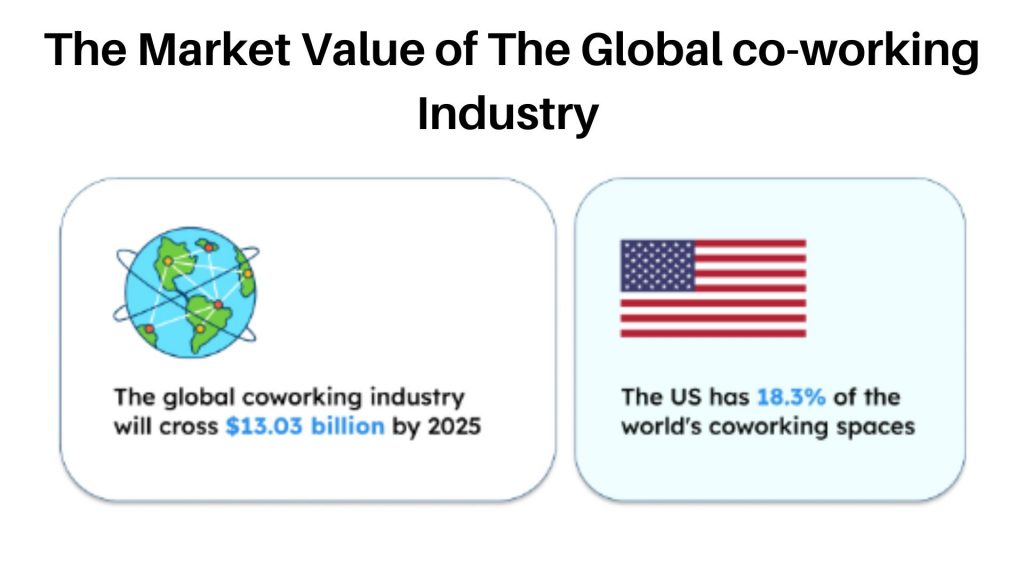 (Source: gototheaddress.com)
(Source: gototheaddress.com)
- By the end of 2025, the market value of the global co-working industry will grow by $13.03 billion.
- As of 2023, the United States has having 18.3% market share in the world’s co-working spaces.
- Currently, there are more than 6,200 co-working spaces in the U.S., and above 1 billion professionals are involved in co-working spaces.
- Over the world, the leading player in the co-working industry is the “International Workplace Group” (IWG).
- IWG was available across more than 110 countries and 1000+ cities with more than 3000+ co-working spaces.
- , the 2nd leading player is “Wework” which has around 800 locations within 119 cities.
by Co-working Benefits
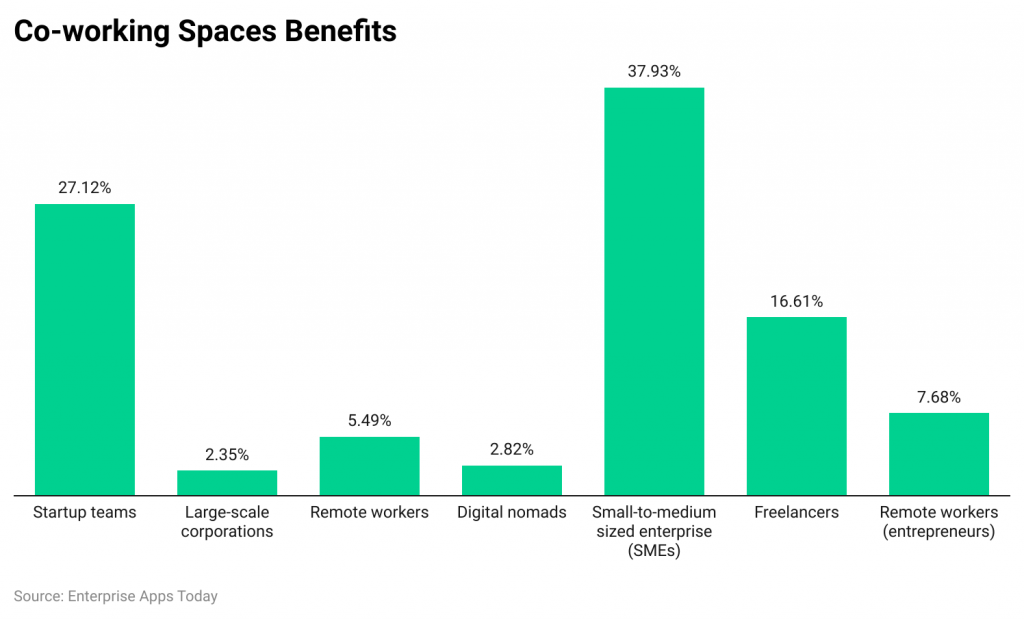 (Source: .theofficepass.com)
(Source: .theofficepass.com)
- According to the reports of the Economic Times, companies working from co-working space help save 30% on operational costs.
- Approximately, 72% of landlords believed that working with co-working spaces results positively in building communities.
- It was also been reported by 83% of individuals that working from co-working spaces enabled less isolation and loneliness.
- After joining a co-working space almost 82% of respondents have expanded their professional network.
- After joining the co-working workplace almost 79.7% 0f people remained both mentally and physically active.
- Co-working spaces are used by 37.93% of small and medium-sized businesses, this is followed by Startup teams (27.12%), and freelancers (16.61%).
Co-working Space Utilization Statistics by Country
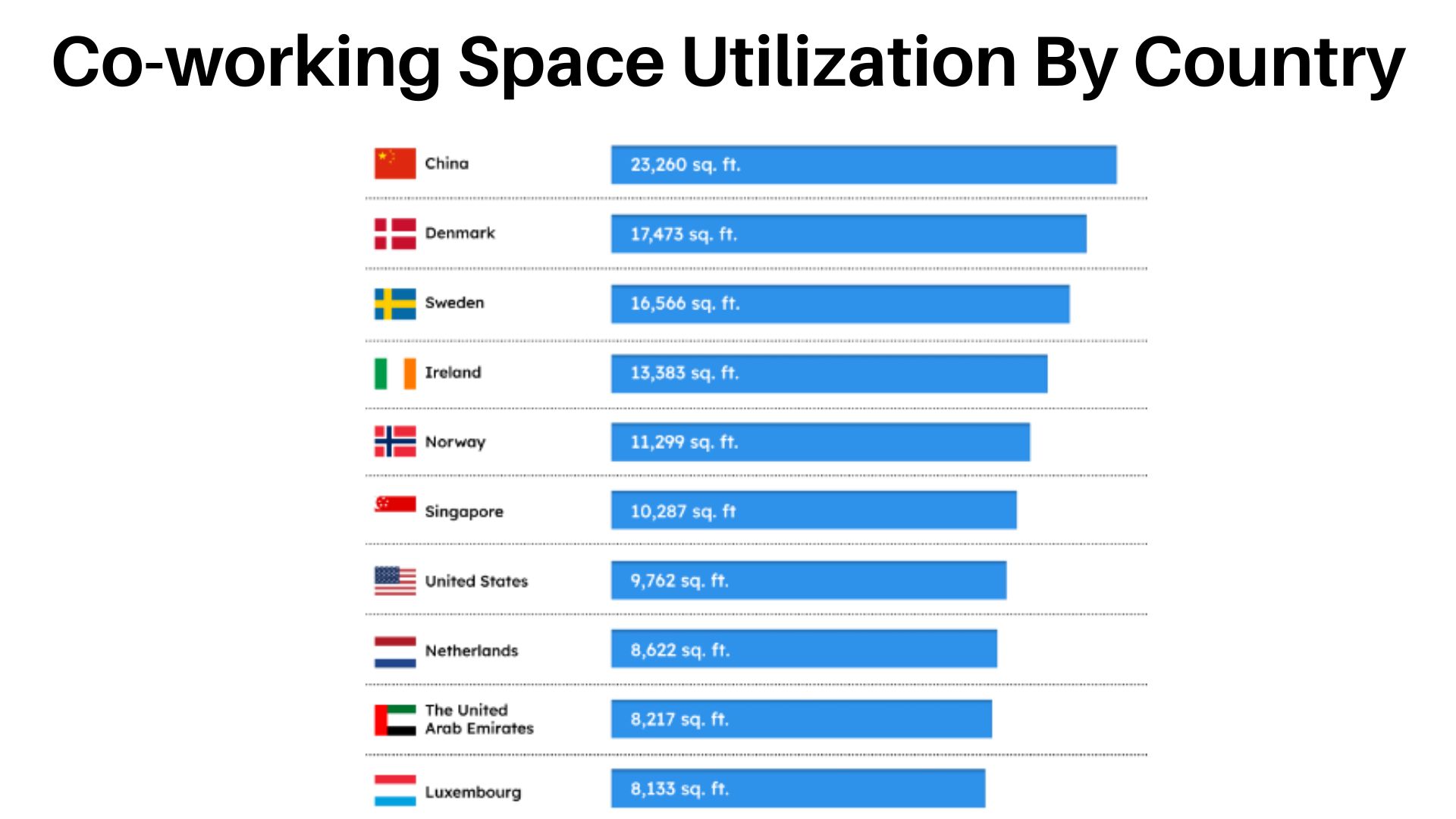 (Source: gototheaddress.com)
(Source: gototheaddress.com)
- The largest working space is observed in North America with an average size of 9,799 sq. ft followed by the average size of the second largest co-working space in Asia at 8,101 sq. ft and Europe with 7,244 sq. ft
- As of 2023, the highest average size of co-working is in China with 23,260 square footage (sq. ft)
- Furthermore, other countries are followed by Denmark (17,473 sq. ft), Sweden (16,566 sq. ft), Ireland (13,383 sq. ft), Norway (11,299 sq. ft), Singapore (10,287 sq. ft), United States (9,762 sq. ft), Netherlands (8,622 sq. ft), The United Arab Emirates (8,217 sq. ft), Luxembourg (8,133 sq. ft), Canada (8,123 sq. ft), Turkey (8,100 sq. ft), The United Kingdom (7,969 sq. ft), Hong Kong (7,912 sq. ft), Vietnam (7,404 sq. ft), Georgia (7,338 sq. ft), India (7,113 sq, ft), Germany (7,079 sq. ft), Australia (7,004 sq. ft), Mexico (6,979 sq. ft), Jordan (6,787 sq. ft), Lebanon (6,600 sq. ft), South Africa (6,565 sq. ft), Andorra (6,500 sq. ft), and Slovakia (6,375 sq. ft)
by Workers
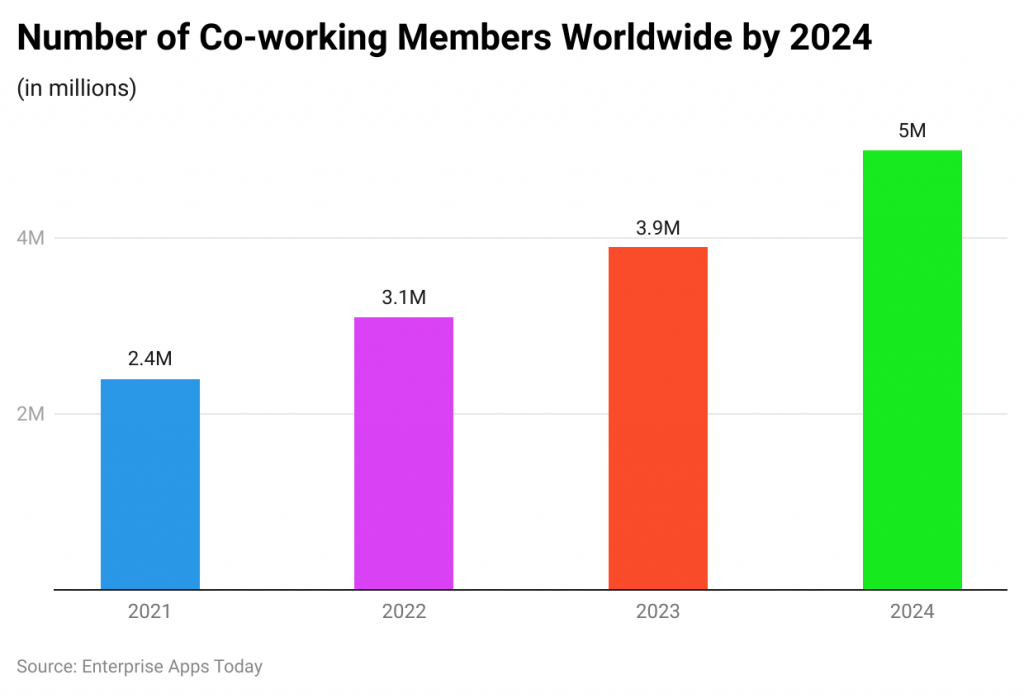 (Source: ergonomictrends.com)
(Source: ergonomictrends.com)
- As of 2022, the number of people using co-working spaces across the world was 3,107,230 which has increased from last year.
- The number of co-working people is expected to reach 3,939,191 by the end of 2023.
- Whereas, by 2024 worldwide co-working spaces are going to be 4, 99,910.
by Demographics
- By the end of 2022 across the world, the average age of the co-working space members was aged around 36 years.
- In the United States, almost 90% of co-working members were White Americans or Caucasians, of which 5% were identified as Asian.
- As of 2022, almost 16% of co-working companies were based on black-owned.
- The users of co-working space are Gen Z and Millennials resulting in 62%, which is followed by Gen X (33%), and Baby Boomers (5%).
- Among professional fields, the largest sector of co-working space covered IT with a 20% share, which is followed by PR, marketing, consulting, and design.
- As of 2022, over the world 42% of co-working members were freelancers and the rest were employees of different companies.
- Of worldwide co-working space members 80% had college degree in which other academic education share was followed by Bachelor’s degree (41%), Master’s degree (41%), and Ph.D holder (4%).
Co-working Spaces Market Statistics by Region and Country
- As of 2023, Asia-Pacific becomes the global leader with 11,000 co-working spaces which is 1/3rd of worldwide co-working spaces.
- In South America, the co-working spaces have expanded with a CAGR of 4.5% from last year.
- On the other hand, in Europe, the rate of co-working spaces has increased by 4.7% of CAGR resulting in 6,850 co-working spaces in 2023.
- In the Asia-Pacific region, Hong Kong is the leading city with above 365 co-working centers.
- Furthermore, the UAE will have more than 176 co-working spaces by the end of 2022.
- In the 1st quarter of 2022, in Saudi Arabia, the market share of co-working has increased by $44 billion.
- As of 2023, in North America, 35% of co-working spaces turned out profitable and in Europe only 27% of co-working spaces are profitable.
- Whereas, over the world, 30% of global co-working spaces are profitable to date.
by Workspace Business
- According to a Royal Society study, it has been observed that 70% of face-to-face communication has decreased in open co-working environments.
- Almost 43% of businesses were have a staff complement under 1000 have adopted co-working.
- For enhancing productivity, 73% of businesses have mostly open spatial set-ups.
- Whereas, the latest technology and tools were used by 33% of businesses that used shared space.
- Goof co-working space allowed in enhancing team collaboration and team building agreed by 43% of businesses.
- Over the world, 40% of companies that used co-working spaces were profitable.
- In the United States, only 6% of businesses have conducted from these spaces in 2022.
- As of 2023, services used in co-working spaces are decreased by community-oriented services by 63%, hot desk (39%), working hours per staff (37%), and number of staff (33%).
Statistics Co-working Space Providers
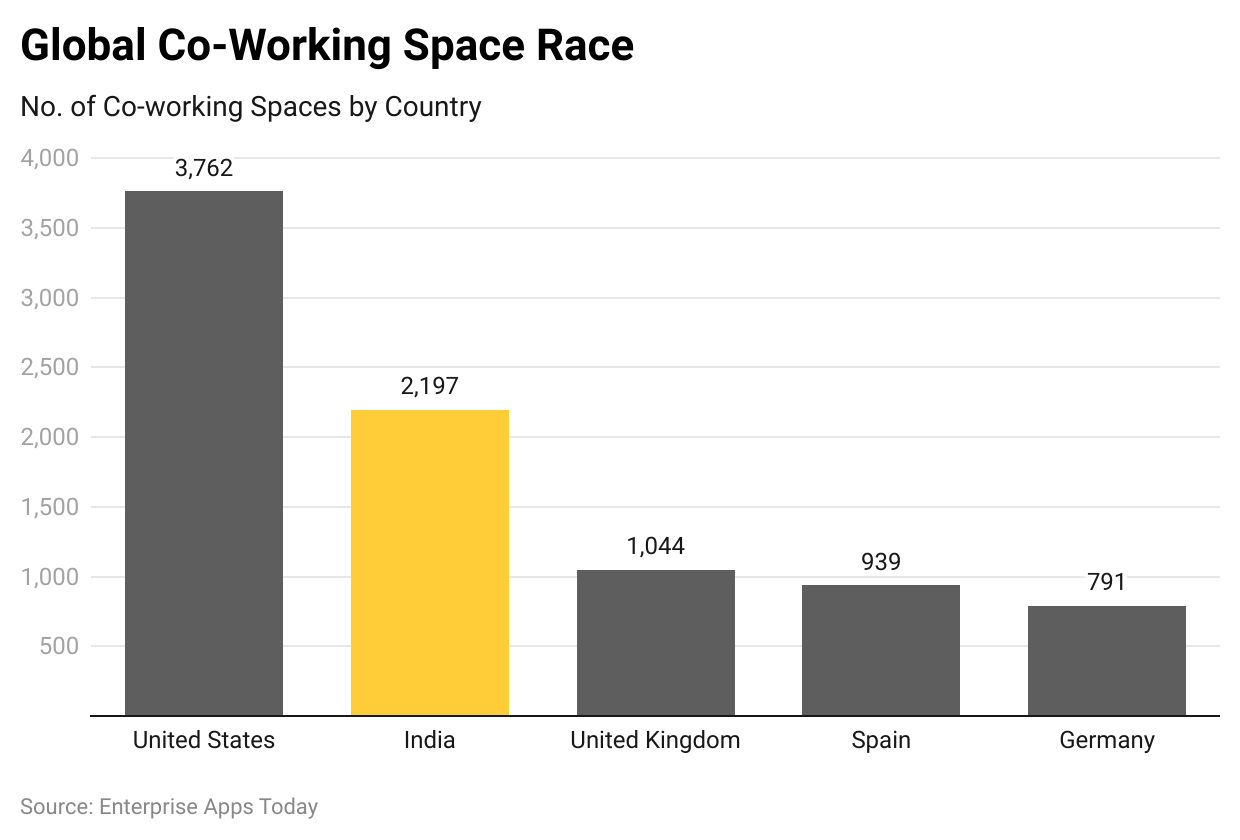 (Source: publit.io)
(Source: publit.io)
- The United States holds the highest number of co-working spaces with 3,762 and the share across the world resulting 18.30%.
- Followed by other countries with number of co-working spaces and world share are India (2,197 and 10.69%), United Kingdom (1,044 and 5.08%), Spain (939 and 4.57%), Germany (791 and 3.85%), Canada (617 and 3%), Australia (590 and 2.87%), Mexico (508 and 2.47%), Japan (411 and 2%), and Brazil (393 and 1.91%).
by Spaces in Demand
- By the end of 2022, the co-working spaces in the urban region increased meeting spaces by 60% which is followed by 53% team offices, and 515 individual offices.
- In suburban areas, the co-working spaces have increased by 52% to individual offices, 49% to meeting spaces, and 23% to hot desks.
- Whereas, in rural areas, co-working spaces have increased by 58% meeting spaces, 48% individual spaces, and 33% event spaces.
by Location, Perks, and Amenities
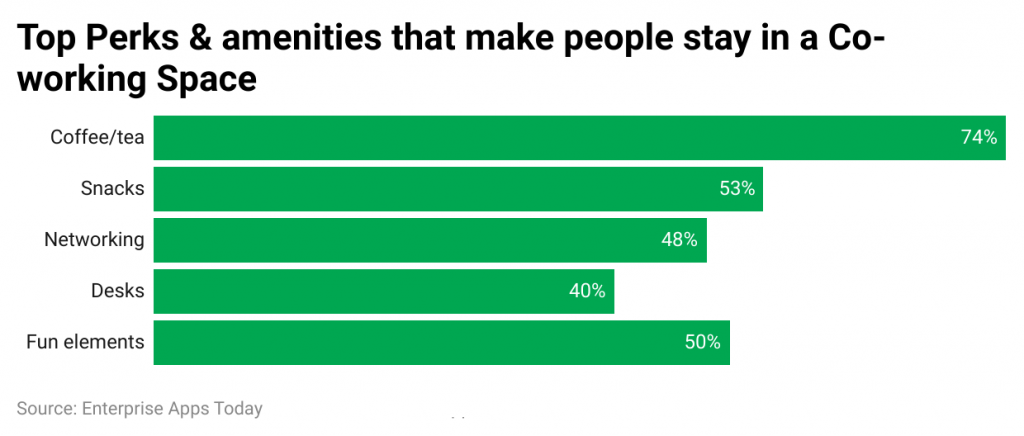 (Source: imagekit.io)
(Source: imagekit.io)
- As of 2023, the global location share of co-working spaces is 69% residential, 12% industrial, 11% commercial, 4% retail, and 4% others.
- The top perks and amenities that make people stay in a co-working space are coffee (74%), snacks (53%), fun element (50%), Networking (48%), and Desks (40%)
by Desk Cost
- The most expensive country in the world with the highest co-working desk price in Oceania resulting in $347 per month.
- While in North America, the average monthly cost of a co-working desk is $246 in 2023.
- Furthermore, followed by desk cost of co-working in Europe is $225 / month and in Asia ($163 / month)
- Over the world, the average monthly cost of a co-working desk was $127 to $285 from the year 2022 to 2023.
by Top Players
- Across the world, the top player in the co-working space market is “Knotel”, headquartered in New York U.S. and the revenue earned is $207.26 billion.
- 2nd player is “The District Cowork” headquartered in New York holding an annual revenue of $6 million.
- The 3rd and 4th to players in the co-working space market are “Techspace” and “Venture X” with revenue of $14.46 million and $4.9 million respectively.
- The other top players revenue is followed by “MakeOffices” ($2.71 million), “Your Alley” ($9 million), Serendipity ($226.111 billion), “WeWork” ($3.2 billion), “Spaces” ($21.83 million), and “IWG” ($10 billion)
by Productivity
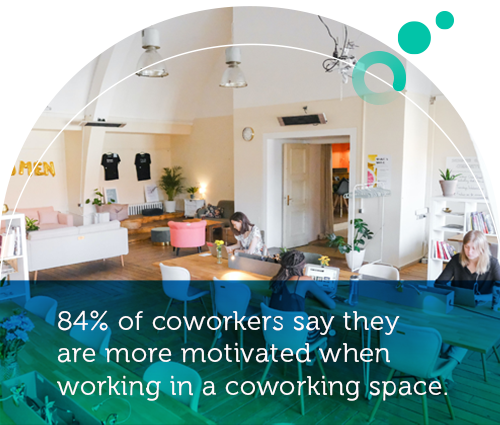
(Source: myshortlister.com)
- According to GCUC’s survey report, the co-working hub kept 84% of coworkers more motivated.
- Whereas, improved the work-life balance of 71% of co-working staff.
- The use of social networking has enhanced within co-working hubs resulting in positive said by 82% of workers.
- Almost 68% of co-working workers have increased focus which enhances profitable productivity.
- The co-working industry helped 69% of workers to learn new productive skills.
- Even 64% of worldwide co-working people have completed their tasks on time in 2022.
Conclusion
As of now after completing the Co-working Statistics it can stated that co-working spaces allow to set up shop for a day or two each week, startup companies can conduct meetings, work full time, and remote employees are able to work as of their choice. The main principle of the co-working industry helps in enabling affordability, flexibility, and productivity. It has been observed that the United States is the major player in the co-working industry all over the world. This article includes many existing co-working statistics that will clearly demonstrate different worldwide shares of the co-working industry.
Sources
FAQ.
By the end of 2022, the number of people using co-working spaces across the globe was nearly 3.1 million, and in the United States, about 1.08 million workers were using them an increase of 27% from the last two years.
The top complaints among global co-working members are noise and lack of privacy, followed by other challenges such as fluctuations in memberships said by 58% of co-working space operators, and 47% of them struggled because of not having enough event spaces and meeting rooms.
Yes, it can be easily said that co-working seems to be the future of work and as of current remote work statistics it is expected that by the end of 2025, the American users are going to be 36 million.

Barry is a lover of everything technology. Figuring out how the software works and creating content to shed more light on the value it offers users is his favorite pastime. When not evaluating apps or programs, he's busy trying out new healthy recipes, doing yoga, meditating, or taking nature walks with his little one.